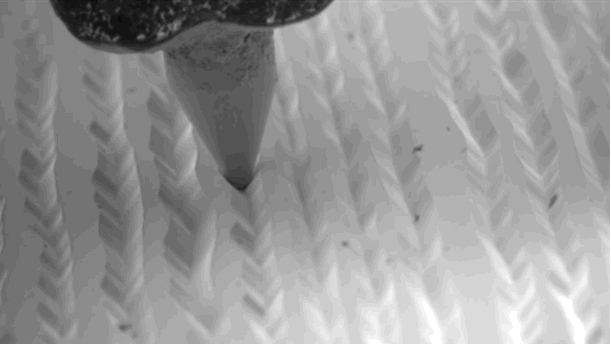How Does Vinyl Work?

Have you ever wondered how something as complicated as a song can be perfectly recorded onto the surface of a flat, round disk of vinyl, that can be reproduced on mass for anyone to own, play and listen to whenever they choose?
The history of recording and reproducing sound
Having access to music whenever and wherever you want is something many of us take for granted but have you ever imagined what it was like before this was possible? Before we had discovered a way to record and playback sound the only way to hear music was to have someone play it, or play it oneself. Imagine what a massive conceptual shift recorded music would had been for people once they were able to hear music, at will, without someone performing it in their presence for the first time. To fully understand the genius behind vinyl you first need to know the origins and history of recording and reproducing sound.
The history of recording and reproducing sound is a period spanning over a century. In 1877 Thomas Edison invented a device that could record and reproduce sound for the first time, not on a disc but a metal cylinder. The term ‘gramophone’ was coined by Emile Berliner whose system played lateral-cut disc records the were first marketed in Europe in 1889. The golden age for vinyl records as we know them was from the inception of the vinyl LP in 1948 to 1988 when CDs out sold vinyl for the first time, but vinyl had its first taste of competition from the Phillip’s Cassette, when it was released in 1962.
After decades of music seemingly disappearing into a computer hard drive, january 2017 saw Vinyl sales topping three million, the highest UK total in 25 years. More than 3.2 million records were sold in 2016, a rise of 53% on the previous year. If you are someone who considers themselves passionate about music, vinyl remains the singular most impressive format of recording and reproducing music. So it's only right we honour the vinyl record by fully understanding the genius behind it.

Sound waves
To understand the genius behind vinyl you first need to understand how sound waves work. Sounds are produced by vibrations and travel through the air as waves, which are vibrating particles. The waves transfer energy from the source of the sound out to its surroundings. Your ear detects sound waves when vibrating air particles cause your eardrum to vibrate. The bigger the vibrations the louder the sound. The groove you can see on a vinyl record is like a fingerprint of the sound waves captured in a lacquer disc that we call a vinyl record. These three-dimensional cuts within the spiral groove on the vinyl record are a recording of how the sound waves behave as they move through the air.


The stylus and the grooves
A typical record player has a type of needle called a stylus that is placed gently on the vinyl record resting in the beginning of the spiral groove. As the vinyl disc steadily rotates the stylus moves through the wavy three dimensions that are cut into the spiral groove. The stylus is a tiny crystal of sapphire or diamond mounted at the very end of a lightweight metal bar like a needle. As the crystal vibrates in the groove, its microscopic bounces are transmitted down the bar. The stylus fits onto the end of an electromagnetic device called a cartridge, containing a piezoelectric crystal. The metal bar presses against the crystal and each time it moves, it wobbles the crystal slightly, generating an electrical signal. These signals are fed out to the amplifier to make the sounds you hear through your speakers or headphones. Not all record-player cartridges use piezoelectricity to convert sound vibrations to electrical signals. Some have tiny electrical coils and a magnet inside them. When the stylus moves, it pushes the magnet up and down past the coil, generating electrical signals that are fed to the amplifier to create sound through your speakers.

Many record collectors and DJs say the sound of vinyl is far superior and much "warmer" than digital music and this is why vinyl has always been the first choice for any music connoisseur. However, this is factually incorrect. The Whittaker Nyquist Kotelkinov Shannon Sampling Theorem describes how sound waves can be replicated perfectly using a sampling rate twice that of the frequency limit when using a band-limited signal.
The revival of vinyl is testament to its appeal and nostalgia. There is something undeniably enjoyable about collecting, playing and mixing with vinyl. If you would like to learn how to beatmatch and mix with vinyl records click here to contact us.
Are you passionate about music? Discover a new musical talent by learning how to DJ or by learning the art of music production. Or if you already have some experience behind the decks, why not build refine your existing DJ skills. Are you looking for a unique gift experience for a music obsessed friend? Take a look at our range of intermediate and advanced DJ courses. We offer 1 to 1 tuition for all experience levels and music genres? Our students learn faster, gain more success and regularly secure gigs at Ministry of Sound, Egg and Electric Brixton and our Music Production students have been signed to Spinnin, Universal and Island Records! This is probably why London Sound Academy has been rated the best DJ and Music Production school in London since 2010.